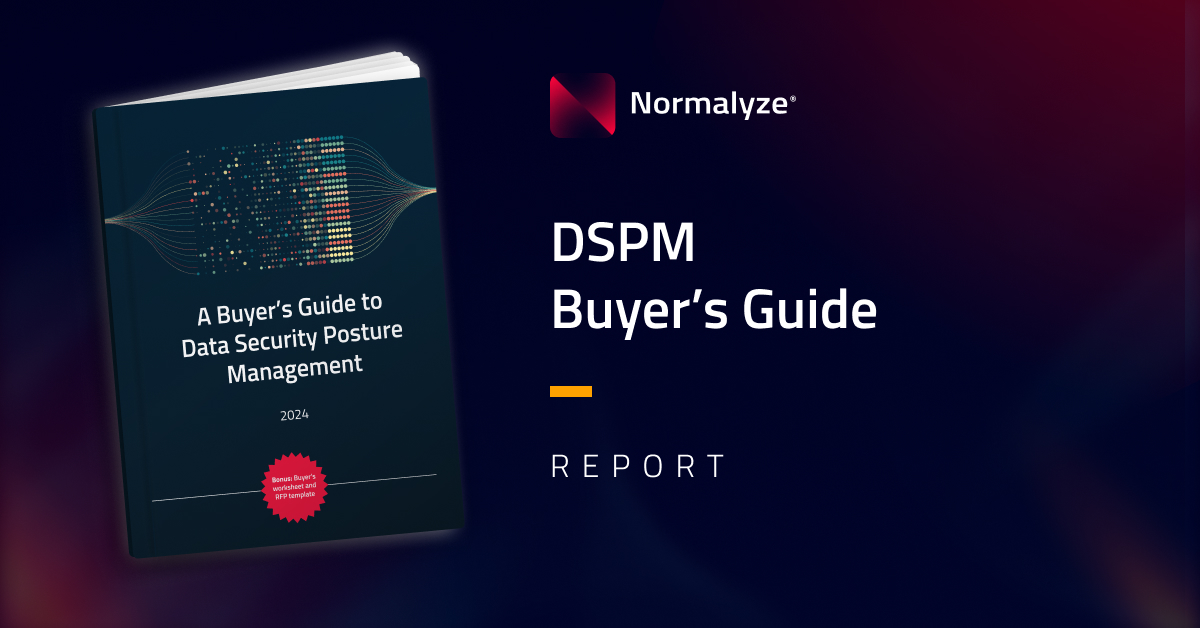Data is the backbone of your organization’s success—fueling informed decision-making, streamlining operations, enhancing customer experiences, and driving innovation. But without proper governance, you may not achieve these benefits. That’s where Data Access Governance (DAG) comes into play. DAG ensures that the right users have access to the right data, unlocking its full potential while reducing operational costs and mitigating risk.
As a key component of Data Security Posture Management (DSPM), DAG ensures the appropriate management, control, and monitoring of access to data within an organization. It involves defining policies and procedures for who can access specific types of data, under what conditions, and how that access is tracked and enforced.
DAG achieves the most benefits for organizations when paired with accurate data discovery and classification. When data remains unclassified or is misclassified, it becomes nearly impossible to apply precise access controls. A data classification solution enables teams to focus on the data stores that contain valuable or sensitive information like Personally Identifiable Information (PII) and provides a deep and nuanced understanding of all your data, so you can fully optimize your data lifecycle.
With DAG in place, let’s explore how it directly contributes to boosting your organization’s productivity and profitability.
1. Get better access to better data with DAG
How can you improve your organization’s productivity through data access governance?
- Data access: By enabling organizations to grant data access easily and accurately, DAG helps organizations make better-informed decisions. Access to high-quality, well-governed data can lead to the identification of new business opportunities, improved customer targeting, and optimized product offerings.
- Data quality: Tracking data along with who accesses it enables organizations to reduce access to dirty or stale data that pollutes good data with outdated, incorrect, or incomplete information. DAG helps direct users to the correct data to do their jobs properly.
2. Maximize value from Snowflake
Snowflake has transformed data analysis, storage, and collaboration, but the high volume and velocity of data in Snowflake environments demand precise control over data access.
Data classification and data access governance tools help provide visibility, organization, and control over the vast and complex access structures that result from Snowflake implementations. Use these tools to reduce waste and minimize risk by identifying inactive, dormant, misconfigured, or over-provisioned users and adjusting their permissions accordingly.
3. Optimize Your Risk Management
Data access governance is one of the most efficient and cost-effective ways to get comprehensive control over your data security, which reduces cost.
Here are some ways that data access governance, in particular, can reduce risk and optimize data security:
- Prevent Data Breaches: By implementing strong data access controls and continuously monitoring access, organizations can reduce the risk of data breaches, which result in significant financial losses. By focusing your security resources on users who have access to valuable or sensitive data, you can ensure your security efforts are directed where they are most needed.
- Reduce user risk: DAG enables security teams to identify users with access to sensitive data who lack necessary security measures like MFA and enforce stricter authentication policies. DAG supports a regular practice of access reviews and enables enforcement of role-based access controls and the principle of least privilege. These best practices reduce the likelihood of account takeover, and they minimize the impact of a potential breach by reducing the likelihood of privilege escalation.
- Limit Insider Threats: Effective DAG reduces the risk of insider threats by ensuring that employees are not over-provisioned, thus minimizing the potential for data misuse or theft.
- Detect anomalies: DAG includes alerting on unusual activities, like unauthorized access or larger-than-normal data transfers which can indicate data exfiltration attempts. By tracking and analyzing data access, DAG adds depth to your defenses and enables rapid response to potential security threats.
- Reduce exposure risk from AI: DAG can make sure sensitive data is not accidentally exposed to AI systems by highlighting which resources have access to sensitive data so that proper controls can be enforced.
- Understand and remediate attack paths: The combination of DAG and data discovery / classification allows you to map the users and resources with access to sensitive data that also have vulnerabilities. These attack paths are how malicious users get to sensitive data. The ability to identify attack paths provides comprehensive visibility into each resource’s exposure level, and enables security teams to focus on remediating the issues with the highest risk first.
- Ensure business continuity: By preventing unauthorized access and ensuring compliance, DAG helps maintain the trust of customers and partners, which is essential for ongoing business success and profitability.
4. Enhance operational efficiency
- Support scalable business operations: As organizations grow, managing data access can become complex. DAG helps automate and scale access control policies efficiently, ensuring that growth does not come at the expense of security or operational efficiency. This allows the organization to expand without unnecessary overhead, contributing to increased profits.
- Improve collaboration: Clear data access policies and governance enable smoother collaboration across teams by streamlining access to data. This can lead to faster decision-making and project completion.
5. Data storage cost reduction
With a data access governance strategy, you can reduce your total amount of used storage and reduce costs, improving your monthly profits:
- Identify and eliminate abandoned data: DAG enables organizations to determine what data is not being accessed, often a clear indicator of abandoned data. A scan of one customer’s cloud environment revealed data costing them $180k annually in storage fees. They were able to offload valuable and sensitive data to cold storage and delete the rest.
- Prevent unnecessary data processing & storage: By setting clear data usage guidelines for roles and users, organizations can use DAG to create processes that prevent excessive and unnecessary data processing and storage — preventing wasteful practices before they occur.
6. Improve customer trust and retention
- Build trust: Effective data access governance ensures that customer data is handled securely and compliantly. This builds trust with customers, leading to higher satisfaction and loyalty, which directly impacts revenue and profitability.
- Enhance brand reputation: A strong reputation for data security can be a competitive advantage, attracting new customers and retaining existing ones.
7. Avoid compliance and regulations fees
Data access governance leads to better regulatory compliance, helping organizations avoid fees—as well as the data leakage dangers those compliances seek to prevent.
Using data access governance to ensure affordable compliance:
- Avoid regulatory violations: Many regulations and standards, such as GDPR, HIPAA, SOX, and PCI-DSS, require organizations to implement access controls that align with the principle of least privilege. Failing to do so can result in non-compliance penalties, fines, and legal actions. DAG tools can regulate data stores, preventing compliance violations and mitigating potential trouble areas where the risk of compliance violations may increase over time.
- Prevent audit failures: Lack of enforcement can result in audit failures, which can impact the organization’s credibility and lead to further scrutiny, potentially setting your organization up for future fees and penalties, fines, and legal fees down the line.
- Lower cyber insurance costs: Organizations with strong data access governance practices may benefit from lower cyber insurance premiums, as they are perceived as lower risk by insurers.
Normalyze: Reducing Risk & Monthly Fees with Data Access Governance
Normalyze DSPM saves organizations money through comprehensive data access governance capabilities working in conjunction with data identification and classification. Organizations can eliminate abandoned data, reduce data security risks, and get the most out of Snowflake investments.
With Normalyze DSPM, you can access audits, privilege analysis, and implement continuous and automated auditing. With our Data Access Graphs, review and audit the data being accessed at a granular level, map role-based access and privileges, and adopt the least privilege model across vast stores of data.
Interested in learning how else Normalyze DSPM can improve your organization’s profits? Request a free demo today.

